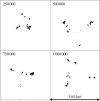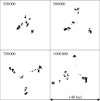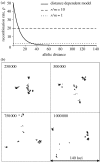Modelling bacterial speciation
- PMID: 17062418
- PMCID: PMC1764933
- DOI: 10.1098/rstb.2006.1926
Modelling bacterial speciation
Abstract
A central problem in understanding bacterial speciation is how clusters of closely related strains emerge and persist in the face of recombination. We use a neutral Fisher-Wright model in which genotypes, defined by the alleles at 140 house-keeping loci, change in each generation by mutation or recombination, and examine conditions in which an initially uniform population gives rise to resolved clusters. Where recombination occurs at equal frequency between all members of the population, we observe a transition between clonal structure and sexual structure as the rate of recombination increases. In the clonal situation, clearly resolved clusters are regularly formed, break up or go extinct. In the sexual situation, the formation of distinct clusters is prevented by the cohesive force of recombination. Where the rate of recombination is a declining log-linear function of the genetic distance between the donor and recipient strain, distinct clusters emerge even with high rates of recombination. These clusters arise in the absence of selection, and have many of the properties of species, with high recombination rates and thus sexual cohesion within clusters and low rates between clusters. Distance-scaled recombination can thus lead to a population splitting into distinct genotypic clusters, a process that mimics sympatric speciation. However, empirical estimates of the relationship between sequence divergence and recombination rate indicate that the decline in recombination is an insufficiently steep function of genetic distance to generate species in nature under neutral drift, and thus that other mechanisms should be invoked to explain speciation in the presence of recombination.
Figures





Similar articles
-
Recombination and the nature of bacterial speciation.Science. 2007 Jan 26;315(5811):476-80. doi: 10.1126/science.1127573. Science. 2007. PMID: 17255503 Free PMC article. Review.
-
Homologous recombination in Agrobacterium: potential implications for the genomic species concept in bacteria.Mol Biol Evol. 2009 Jan;26(1):167-76. doi: 10.1093/molbev/msn236. Epub 2008 Oct 20. Mol Biol Evol. 2009. PMID: 18936442
-
Speciation trajectories in recombining bacterial species.PLoS Comput Biol. 2017 Jul 3;13(7):e1005640. doi: 10.1371/journal.pcbi.1005640. eCollection 2017 Jul. PLoS Comput Biol. 2017. PMID: 28671999 Free PMC article.
-
Genetic exchange across a species boundary in the archaeal genus ferroplasma.Genetics. 2007 Sep;177(1):407-16. doi: 10.1534/genetics.107.072892. Epub 2007 Jul 1. Genetics. 2007. PMID: 17603112 Free PMC article.
-
The interplay of homologous recombination and horizontal gene transfer in bacterial speciation.Methods Mol Biol. 2009;532:29-53. doi: 10.1007/978-1-60327-853-9_3. Methods Mol Biol. 2009. PMID: 19271178 Review.
Cited by
-
Recombination and the nature of bacterial speciation.Science. 2007 Jan 26;315(5811):476-80. doi: 10.1126/science.1127573. Science. 2007. PMID: 17255503 Free PMC article. Review.
-
Global biogeography of chemosynthetic symbionts reveals both localized and globally distributed symbiont groups.Proc Natl Acad Sci U S A. 2021 Jul 20;118(29):e2104378118. doi: 10.1073/pnas.2104378118. Proc Natl Acad Sci U S A. 2021. PMID: 34272286 Free PMC article.
-
How clonal are Neisseria species? The epidemic clonality model revisited.Proc Natl Acad Sci U S A. 2015 Jul 21;112(29):8909-13. doi: 10.1073/pnas.1502900112. Proc Natl Acad Sci U S A. 2015. PMID: 26195766 Free PMC article.
-
Independently evolving species in asexual bdelloid rotifers.PLoS Biol. 2007 Apr;5(4):e87. doi: 10.1371/journal.pbio.0050087. PLoS Biol. 2007. PMID: 17373857 Free PMC article.
-
Where does Campylobacter come from? A molecular odyssey.Adv Exp Med Biol. 2010;659:47-56. doi: 10.1007/978-1-4419-0981-7_4. Adv Exp Med Biol. 2010. PMID: 20204754 Free PMC article. Review. No abstract available.
References
-
- Cohan F.M. What are bacterial species? Annu. Rev. Microbiol. 2002;56:457–487. doi:10.1146/annurev.micro.56.012302.160634 - DOI - PubMed
-
- Falush D, Torpdahl M, Didelot X, Conrad D.F, Wilson D.J, Achtman M. Mismatch induced speciation in Salmonella: model and data. Phil. Trans. R. Soc. B. 2006;361:2045–2053. doi:10.1098/rstb.2006.1925 - DOI - PMC - PubMed
-
- Feil E.J, Spratt B.G. Recombination and the population structures of bacterial pathogens. Annu. Rev. Microbiol. 2001;55:561–590. doi:10.1146/annurev.micro.55.1.561 - DOI - PubMed
-
- Fraser C, Hanage W.P, Spratt B.G. Neutral microepidemic evolution of bacterial pathogens. Proc. Natl Acad. Sci. USA. 2005;102:1968–1973. doi:10.1073/pnas.0406993102 - DOI - PMC - PubMed
-
- Gevers D, et al. Opinion: re-evaluating prokaryotic species. Nat. Rev. Microbiol. 2005;3:733–739. doi:10.1038/nrmicro1236 - DOI - PubMed
Publication types
MeSH terms
Grants and funding
LinkOut - more resources
Full Text Sources

